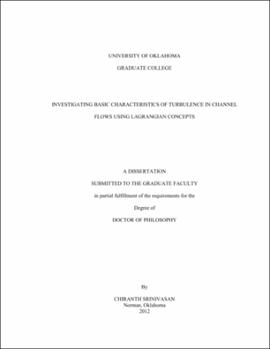| dc.contributor.advisor | Papavassiliou, Dimitrios V | |
| dc.creator | SRINIVASAN, CHIRANTH | |
| dc.date.accessioned | 2019-04-27T21:28:43Z | |
| dc.date.available | 2019-04-27T21:28:43Z | |
| dc.date.issued | 2012 | |
| dc.identifier | 99219748702042 | |
| dc.identifier.uri | https://hdl.handle.net/11244/318779 | |
| dc.description.abstract | Many examples of turbulent motion of particles in nature can be better perceived through the concept of backwards turbulent dispersion. Some examples include pollutants in atmosphere or oceans reaching populated human or marine life, mixing scenarios where components are moving towards the mixing location, or temperature noise at a certain downwind location. In these scenarios, turbulent dispersion occurs as the particles diffuse towards a particular location. The combined direct numerical simulation/Lagrangian scalar tracking (DNS/LST) approach is used to obtain Lagrangian statistics of turbulent scalar field. This provides a natural and convenient framework to compute statistics for turbulent backwards scalar dispersion. Using this method, the forwards and backwards single particle and relative dispersion statistics are calculated. The rates of dispersion and the principal direction of transport of heat are studied. Four main regions of the channel, namely, viscous sub-layer, transition region, logarithmic region and center of the channel, are studied with interest. The dispersion characteristics are also analyzed for different types of fluids, including but not limited to, Pr = 0.1 (liquid metal regime), Pr = 0.7 (air), Pr = 10 (water), Pr = 100 to 50000 (heavy oils, engine oils). The results of the study show clear differences in the rates and direction of heat transport for the forwards and backwards dispersion. A term called "turbulent dispersive ratio" is established as a parameter to capture the differences in the direction of forwards and backwards scalar transport. | |
| dc.description.abstract | A vast DNS/LST database generated over the years in the cases of different Re and Pr is utilized to propose and verify a scaling parameter to capture turbulent heat transport. This scaling parameters, identified as the location and the value of the maximum normal turbulent heat flux, capture all the inner scales, which are the scales of turbulent flows in the near wall regions of the channel, while exhibiting universality in capturing the scalar profiles of mean, fluctuations, and scalar flux. | |
| dc.description.abstract | Finally, the versatile DNS/LST particle method is used to translate the theoretical framework of Churchill to calculate the turbulent Prandtl number (Prt). The study provides the first-of-a-kind dependency data for Prt for different wall normal locations and different molecular Prt. The results reveal a dependence of Prt on the Pr, especially very close to the wall. | |
| dc.format.extent | 285 pages | |
| dc.format.medium | application.pdf | |
| dc.language | en_US | |
| dc.relation.requires | Adobe Acrobat Reader | |
| dc.subject | Turbulence--Mathematical models | |
| dc.subject | Lagrangian functions | |
| dc.title | Investigating basic characteristics of turbulence in channel flows using Lagrangian concepts | |
| dc.type | text | |
| dc.type | document | |
| dc.thesis.degree | Ph.D. | |
| ou.group | College of Engineering::School of Chemical, Biological and Materials Engineering | |
